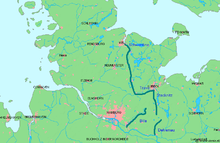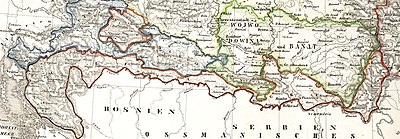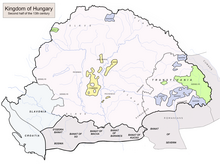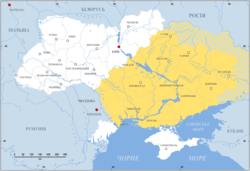March (territory)
Inmedieval Europe,amarchormarkwas, in broad terms, any kind ofborderland,[1]as opposed to a state's "heartland". More specifically, a march was a border betweenrealmsor a neutralbuffer zoneunder joint control of two states in which different laws might apply. In both of these senses, marches served a political purpose, such as providing warning ofmilitary incursionsor regulating cross-border trade.
Marches gave rise to titles such asmarquess(masculine) or marchioness (feminine) inEngland;marqués(masculine) andmarquesa(feminine) inSpanish-speaking countries and theCatalanandGalicianregions;marquês(masculine) andmarquesa(feminine) inPortuguese-speaking countries;markesa(both masculine and feminine) inBasque;marquis(masculine) ormarquise(feminine) inFranceandScotland,margrave(German:Markgraf,lit. 'march count'; masculine) or margravine (German:Markgräfin,lit. 'march countess', feminine) inGermany,and corresponding titles in other European states.
Etymology[edit]
The word "march" derives ultimately from aProto-Indo-Europeanroot *mereg-,meaning "edge, boundary". The root *mereg-producedLatinmargo( "margin" ),Old Irishmruig( "borderland" ),Welshbro( "region, border, valley" ) andPersianandArmenianmarz( "borderland" ). TheProto-Germanic*markogave rise to theOld EnglishwordmearcandFrankishmarka,as well asOld Norsemǫrkmeaning "borderland, forest",[2]andderivedfrommerki"boundary, sign",[2]denoting a borderland between two centres of power.
In Old English "mark" meant "boundary" or "sign of a boundary", and the meaning only later evolved to encompass "sign" in general, "impression" and "trace".
TheAnglo-Saxonkingdom ofMerciatook its name fromWest Saxonmearc"marches", which in this instance referred explicitly to the territory's position on the Anglo-Saxonfrontierwith theRomano-Britishto the west.
During the FrankishCarolingian dynasty,usage of the word spread throughout Europe.
The name Denmark preserves the Old Norse cognatesmerki( "boundary" )mǫrk( "wood", "forest" ) up to the present. Following theAnschluss,the Nazi German government revived the old name'Ostmark'for Austria.
Historical examples of marches and marks[edit]
Frankish Empire and successor states[edit]
Marca Hispanica[edit]
After some early setbacks,Charlemagne's sonLouisventured beyond the province ofSeptimaniaand eventually took Barcelona from theMoorishemirin 801. Thus he established a foothold in the borderland between the Franks and the Moors. The Carolingian "Hispanic Marches" (Marca Hispánica) became a buffer zone ruled by a number of feudal lords, among them theCount of Barcelona.It had its own outlying territories, each ruled by a lessermileswith armed retainers, who theoretically owed allegiance through a Count to the Emperor or, with lessfealty,to his Carolingian and Ottonian successors. Such territory had acatlá( "castellan" or lord of the castle) in an area largely defined by a day's ride, and the region became known, like Castile at a later date, as "Catalunya".[citation needed]Counties in thePyreneesthat appeared in the 9th century, in addition to theCounty of Barcelona,includedCerdanya,GironaandUrgell.
In the early ninth century, Charlemagne issued his new kind of land grant, theaprisio,which redisposed land belonging to the Imperialfiscin deserted areas, and included special rights and immunities that resulted in a range of independence of action.[3]Historians interpret theaprisioboth as the basis offeudalismand in economic and military terms as a mechanism to entice settlers to a depopulated border region. Such self-sufficient landholders would aid the counts in providing armed men in defense of the Frankishfrontier.Aprisiogrants (the first ones were inSeptimania) emanated directly from the Carolingian king, and they reinforced central loyalties, to counterbalance the local power exercised by powerful marcher counts.[citation needed]
But communications were arduous, and the power centre was far away. Primitivefeudalentities developed, self-sufficient and agrarian, each ruled by a small hereditary military elite. The sequence in the County of Barcelona exhibits a pattern that emerges similarly in marches everywhere: The count is appointed by the king (from 802), the appointment settles on the heirs of a strong count (Sunifred) and the appointment becomes a formality, until the position is declared hereditary (897) and then the count declares independence (by Borrell II in 985). At each stage thede factosituation precedes thede jureassertion, which merely regularizes an existing fact of life. This isfeudalismin the larger landscape.[citation needed]
Some counts aspired to the characteristically Frankish (Germanic) title "Margraveof the Hispanic March ", a" margrave "being agraf( "count" ) of the march.[citation needed]
The earlyhistory of Andorraprovides a fairly typical career of another such march county, the only modern survivor in the Pyrenees of the Hispanic Marches.[citation needed]
Marches set up by Charlemagne[edit]
- TheDanish March(sometimes regarded as just a series of forts rather than a march) between theEiderandSchleirivers, against theDanes;
- theSaxonorNordalbingenmarch between theEiderandElberivers in modernHolstein,against theObotrites;
- theThuringianorSorbian marchon theSaaleriver, against theSorbsdwelling behind thelimessorabicus;
- theMarch of Lusatia,March of Meissen,March of MerseburgandMarch of Zeitz;
- theFranconian marchin modernUpper Franconia,against theCzechs;
- theAvar marchbetweenEnnsriver andWienerwald(the laterEastern Marchthat became the Margraviate of Austria);
- thePannonian marcheast ofVienna(divided intoUpperandLower);
- theCarantanian march;
- Steiermark (Styria),established under Charlemagne from a part ofCarantania(Carinthia), erected as a border territory against theAvarsand Slavs;
- theMarch of Friuli;
- theMarca Hispanicaagainst the Muslims ofAl-Andalus
France[edit]
Theprovince of FrancecalledMarche(Occitan:la Marcha), sometimesMarche Limousine,was originally a small border district between the Duchy of Aquitaine and the domains of the Frankish kings in central France, partly ofLimousinand partly ofPoitou.[4]
Its area was increased during the 13th century and remained the same until theFrench Revolution.Marche was bounded on the north byBerry,on the east byBourbonnaisandAuvergne;on the south by Limousin itself and on the west by Poitou. It embraced the greater part of the moderndépartementofCreuse,a considerable part of the northernHaute-Vienne,and a fragment ofIndre,up toSaint-Benoît-du-Sault.Its area was about 1,900 square miles (4,900 km2) its capital wasCharrouxand laterGuéret,and among its other principal towns wereDorat,BellacandConfolens.[5]
Marche first appeared as a separate fief about the middle of the 10th century whenWilliam III, duke of Aquitaine,gave it to one of his vassals namedBoso,who took the title ofcount.In the 12th century it passed to the family ofLusignan,sometimes alsoCounts of Angoulême,until the death of the childlessCount Hughin 1303, when it was seized by KingPhilip IV.In 1316 it was made anappanagefor his youngest son the Prince, afterwards KingCharles IVand a few years later (1327) it passed into the hands of thefamily of Bourbon.[5]
The family ofArmagnacheld it from 1435 to 1477, when it reverted to the Bourbons, and in 1527 it was seized by KingFrancis Iand became part of the domains of the French crown. It was divided into Haute-Marche (i.e. "Upper Marche" ) and Basse-Marche (i.e. "Lower Marche" ), the estates of the former being in existence until the 17th century. From 1470 until the Revolution the province was under the jurisdiction of theparlementof Paris.[5]
Several communes of France are named similarly:
- Marches, Drômein theDrômedépartement
- La Marchein theNièvredépartement
Germany and Austria[edit]
The Germanic tribes that Romans calledMarcomanni,who battled the Romans in the 1st and 2nd centuries, were simply the "men of the borderlands".

Marcheswere territorial organisations created as borderlands in theCarolingian Empireand had a long career as purely conventional designations under theHoly Roman Empire.In modern German, "Mark" denotes a piece of land that historically was a borderland, as in the following names:
Later medieval marches[edit]
- Nordmark,the "Northern March", theOttonian empire's territorial organisation on the conquered areas of theWends.In 1134, in the wake of a German crusade against the Wends, the German magnateAlbert the Bearwas granted theNorthern Marchby theHoly Roman EmperorLothar II.
- theMarch of the Billungson theBaltic coast,stretching approximately fromStettin(Szczecin) toSchleswig;
- Marca Geronis(march of Gero), a precursor of theSaxon Eastern March,later divided into smaller marches (theNorthern March,which later was reestablished asMargraviate of Brandenburg;theLusatian Marchand theMeißen Marchin modernFree state of Saxony;theMarch of Zeitz;theMerseburg March;theMilzener MarcharoundBautzen);
- March of Austria(marcha Orientalis,the "Eastern March" or "Bavarian Eastern March" (German:Ostmark) in modern lower Austria);
- theHungarian March
- theCarantania marchorMarch of Styria(Steiermark);
- theDrau March(MarburgandPettau);
- theSann March(Cilli);
- the Krain orMarch of Carniola,alsoWindic marchandWhite Carniola(White March), in modernSlovenia.
- three marches were created in theLow Countries:Antwerp,Valenciennes,Ename.
Other[edit]
- TheMargraviate of Brandenburg,its ruler designatedMarkgraf(margrave, literally "march-count" ). It was further divided into regions also designated "Mark":
- Altmark( "Old March" ), the western region of the former margraviate, betweenHamburgandMagdeburg.
- Mittelmark( "Central March" ), the area surrounding Berlin. Today, this region makes up for the bulk of the Germanfederal stateofBrandenburg,and thus in modern usage is referred to as Mark Brandenburg.
- Neumark( "New March" ) since the 1250s was Brandenburg's eastern extremity betweenPomeraniaandGreater Poland.Since 1945, the area is a part of Poland.
- Uckermark,the Brandenburg–Pomeranian borderland. The name is still in use for the region as well as for aBrandenburgian district.
- Mark,a medieval territory that is recalled in theMärkischer Kreisdistrict (formed in 1975) of today'sNorth Rhine-Westphalia.The northern portion (north of theLippe River) is still calledHohe Mark( "Higher Mark" ). The former "Lower Mark" (between Ruhr and Lippe rivers) is the presentRuhr areaand is no longer called "Mark". The title, in the form "Count of the Mark", survived the territory as a subsidiary title of the Dukes ofSaxe-Coburg and Gotha
- Ostmark( "Eastern March" ) is a modern rendition of the termmarchia orientalisused in Carolingian documents referring to the area ofLower Austriathat was later amarkgraftum(margraviateor "county of the mark" ).Ostmarkhas been variously used to denote Austria, theSaxon Eastern March,or, asOstmarkenverein,the territories Prussia gained in thepartitions of Poland.
Habsburg Empire[edit]

Italy[edit]
This sectionneeds expansion.You can help byadding to it.(June 2008) |
From the Carolingian period onwards the namemarcabegins to appear in Italy, first theMarca Fermanafor the mountainous part ofPicenum,the Marca Camerinese for the district farther north, including a part ofUmbria,and the Marca Anconitana for the formerPentapolis(Ancona). In 1080, themarca Anconitanawas given in investiture toRobert GuiscardbyPope Gregory VII,to whom theCountess Matildaceded the marches ofCamerinoandFermo.
In 1105, theEmperor Henry IVinvestedWernerwith the whole territory of the three marches, under the name of theMarch of Ancona.It was afterwards once more recovered by the Church and governed by papal legates as part of thePapal States.The Marche became part of theKingdom of Italyin 1860. AfterItalian unificationin the 1860s,Austria-Hungarystill controlled territory Italian nationalistsstill claimed as part of Italy.One of these territories wasAustrian Littoral,which Italian nationalists began to call theJulian Marchbecause of its positioning and as an act of defiance against the hated Austro-Hungarian empire.
Marchewere repeated on a miniature level, fringing many of the small territorial states of pre-RisorgimentoItaly with a ring of smaller dependencies on their borders, which represent territorialmarcheon a small scale. A map of theDuchy of Mantuain 1702 (Braudel 1984, fig 26) reveals the independent, though socially and economically dependent arc of small territories from theprincipality of Castiglionein the northwest across the south to the duchy ofMirandolasoutheast ofMantua:the lords ofBozolo,Sabioneta,Dosolo,Guastalla,the count ofNovellare.
Hungary[edit]

In medievalHungarythe system ofgyepűandgyepűelve,effective until the mid-13th century, can be considered as marches even though in its organisation it shows major differences from Western European feudal marches. For one thing, thegyepűwas not controlled by a Marquess.
TheGyepűwas a strip of land that was specially fortified or made impassable, whilegyepűelvewas the mostly uninhabited or sparsely inhabited land beyond it. Thegyepűelveis much more comparable to modernbuffer zonesthan traditional European marches.
Portions of thegyepűwere usually guarded by tribes who had joined the Hungarian nation and were granted special rights for their services at the borders, such as theSzékelys,PechenegsandCumans.A ban on settlement north ofNišby theByzantine Empirein the twelfth century helped to establish uninhabited marchland between the empire's territory and Hungary.[6]
The Hungariangyepűoriginates from theTurkishyapimeaningpalisade.During the 17th and 18th centuries these borderlands were called Markland in the area of Transylvania that bordered with the Kingdom of Hungary and was controlled by a Count or Countess.[7]
Iberia[edit]
In addition to the CarolingianMarca Hispanica,Iberia was home to several marches set up by the native states. The future kingdoms ofPortugalandCastilewere founded as marcher counties intended to protect theKingdom of Leónfrom theCordoban Emirate,to the south and east respectively.
Likewise, Córdoba set up its own marches as a buffer to the Christian states to the north. TheUpper March(al-Tagr al-A'la), centered onZaragoza,faced the easternMarca Hispanicaand the westernPyrenees,and included the Distant or Farthest March (al-Tagr al-Aqsa). TheMiddle March(al-Tagr al-Awsat), centred onToledoand laterMedinaceli,faced the western Pyrenees and Asturias. TheLower March(al-Tagr al-Adna), centred onMéridaand laterBadajoz,facing León and Portugal. These too would give rise to Kingdoms, theTaifasofZaragoza,Toledo,andBadajoz.
[edit]
Denmarkmeans "the march of theDanes".
InNorse,"mark" meant "borderlands" and "forest"; in present-day Norwegian and Swedish it has acquired the meaning "ground", while in Danish it has come to mean "field" or "grassland".
Marklandwas the Norse name of an area in North America discovered by NorwegianVikings.
The forests surrounding Norwegian cities are called "Marka" – the marches. For example, theforests surrounding Osloare calledNordmarka,ØstmarkaandVestmarka– i.e. the northern, eastern and western marches.
In Norway, there are – or have been – the counties:
- Finnmark,"the borderlands of theSámi"(known to theNorseasFinns)
- Hedmark,"the borderlands ofheath"
- Telemark,"the borderlands of theÞela tribe"[8]
In Finland,markoccurs in the following placenames inSatakunta:
- Noormarkku(Swedish: Norrmark), a former municipality of Finland
- Pomarkku(Swedish: Påmark), a municipality of Finland
- Söörmarkku(Swedish: Södermark), a village in Noormarkku, Finland
InVärmlandinSweden,Nordmark Hundredwas the frontier area near the border to Norway. Almost all of it is now a part ofÅrjäng Municipality.In the Middle Ages the area was calledNordmarkernaand was a part ofDalslandand not of Värmland.
British Isles[edit]
This sectionneeds additional citations forverification.(November 2010) |
The name of theAnglo-Saxonkingdom in the midlands of England wasMercia.The name "Mercia" comes from theOld Englishfor "boundary folk", and the traditional interpretation was that the kingdom originated along the frontier between theWelshand the Anglo-Saxon invaders, although P. Hunter Blair has argued an alternative interpretation that they emerged along the frontier between the Kingdom of Northumbria and the inhabitants of theRiver Trentvalley.
Latinizing the Anglo-Saxon termmearc,the border areas between England and Wales were collectively known as theWelsh Marches(marchia Wallia), while the native Welsh lands to the west were considered Wales Proper (pura Wallia). TheNormanlords in the Welsh Marches were to become the newMarcher Lords.
The titleEarl of Marchis at least two distinctfeudal titles:one in the northern marches, as an alternative title for theEarl of Dunbar(c. 1290 in thePeerage of Scotland); and one, that was held by the family ofMortimer(1328 in thePeerage of England), in the westWelsh Marches.
TheScottish Marchesis a term for the border regions on both sides of the border between England and Scotland. From theNorman conquestof England until the reign ofKing James VI of Scotland,who also becameKing James I of England,border clashes were common and the monarchs of both countries relied onMarcher Lordsto defend the frontier areas known as the Marches. They were hand-picked for their suitability for the challenges the responsibilities presented.
Patrick Dunbar, 8th Earl of Dunbar,a descendant of theEarls of Northumbriawas recognized in the end of the 13th century to use the name March as his earldom in Scotland, otherwise known as Dunbar, Lothian, and Northumbrian border.
Roger Mortimer, 1st Earl of March,Regentof England together withIsabella of Franceduring the minority of her son,Edward III,was a usurper who had deposed, and allegedly arranged the murder of, King Edward II. He was created an earl in September 1328 at the height of hisde factorule. His wife wasJoan de Geneville, 2nd Baroness Geneville,whose mother,Jeanne of Lusignanwas one of the heiresses of the FrenchCounts of La MarcheandAngouleme.
His family,MortimerLords ofWigmore,had been border lords and leaders of defenders of Welsh marches for centuries. He selectedMarchas the name of his earldom for several reasons: Welsh marches referred to several counties, whereby the title signified superiority compared to usual single county-based earldoms. Mercia was an ancient kingdom. His wife's ancestors had been Counts of La Marche and Angouleme in France.
InIreland,a hybrid system of marches existed which was condemned as barbaric at the time.[a]The Irish marches constituted the territory between English and Irish-dominated lands, which appeared as soon as the English did and were called by King John to be fortified.[10]By the 14th century, they had become defined as the land betweenThe Paleand the rest of Ireland.[11]Local Anglo-Irish and Gaelic chieftains who acted as powerful spokespeople were recognised by the Crown and given a degree of independence. Uniquely, the keepers of the marches were given the power to terminate indictments. In later years, wardens of the Irish marches took Irish tenants.[12][13][14]
Titles[edit]
Marquis,marchese andmargrave(Markgraf) all had their origins in feudal lords who held trusted positions in the borderlands. The English title was a foreign importation from France, tested out tentatively in 1385 byRichard II,but not naturalized until the mid-15th century, and now more often spelled "marquess".[b]
Related concepts[edit]
This sectionmay contain materialnot related to the topic of the article.(November 2010) |
Abbasid Caliphate[edit]
Armenia[edit]
The specificsubdivisions of Armeniaare each calledmarz, մարզ(pl. "marzer, մարզեր" ), a loanword fromPersian.
The Balkans[edit]
SeeKrajinaandMilitary Frontier.
Byzantine Empire[edit]
China[edit]
The Chinese concept of March is calledFan( phiên ), referring to feudatory domains and petty kingdoms on the borderlands of the empire.
In their initial development during thelater Zhou dynasty,thecommanderies(jùn,Quận ) functioned as marches, ranking below thedukes' andkings'original fiefsand below the more secure and populouscounties(xiàn). As the commanderies formed the front lines between themajor states,however, their military strength and strategic importance were typically much greater than the counties'. Over time, however, the commanderies were eventually developed into regular provinces and then discontinued entirely during theTang dynastyreforms.
Japan[edit]
The European concept ofmarchesapplies just as well to the fief ofMatsumae clanon the southern tip of Hokkaidō which was at Japan's northern border with theAinu peopleofHokkaidō,known asEzoat the time. In 1590, this land was granted to the Kakizaki clan, who took the name Matsumae from then on. The Lords of Matsumae, as they are sometimes called, were exempt from owing rice to theshōgunin tribute, and from thesankin-kōtaisystem established byTokugawa Ieyasu,under which most lords (daimyōs) had to spend half the year at court (in the capital ofEdo).
By guarding the border, rather than conquering or colonizing Ezo, the Matsumae, in essence, made the majority of the island an Ainu reservation. This also meant that Ezo, and theKurile Islandsbeyond, were left essentially open to Russian colonization. However, the Russians never did colonize Ezo, and the marches were officially eliminated during theMeiji Restorationin the late 19th century, when the Ainu came under Japanese control, and Ezo was renamed Hokkaidō, and annexed to Japan.
Persia (Sassanid Empire)[edit]
Roman Empire[edit]
Ukraine[edit]

Ukraine,from the Moscow-centric Russian viewpoint, functioned as a "borderland" or "march" and arguably could have gained its currentname,which is derived from a Slavic term that can take on the same meaning (see above for similar in Slovenia, etc.), ultimately from this function.[citation needed]This, though, was merely a continuation of a semi-formal arrangement with the Poles, before escalating feuds, political infighting in Poland, and religious differences (mainly Eastern Orthodox vs. Roman Catholic) saw a loose coalition of Ukrainian lords and independent landowners collectively known as the Cossacks shift to ally with the Russian Empire.
TheCossacksbecame a significant part of Russian military history in their role as military border/buffer-troops in theWild Fieldsof Ukraine. TheTatar slave raids in East Slavic landsbrought considerable devastation and depopulation to this area prior to the rise of theZaporozhian Cossacks.As settlement advanced and the borders moved, the Tsars transferred or formed Cossack units to perform similar functions on other borderlands/marches further south and east in (for example) the Kuban and in Siberia, forming (for example) theBlack Sea Cossack Host,theKuban Cossack Hostand theAmur Cossack Host.
See also[edit]
Notes[edit]
- ^"In distant Westminster, where it was impossible to imagine the stress of life in the Irish marches, march law (like Irish law, which Edward I had once described as 'detestable to God and contrary to all laws') was outrightly condemned," notes James F. Lydon[9]
- ^The stylingmarquisormarquessis a peculiarity of each title.
- ^Chisholm 1911,p. 689.
- ^ab"Online Etymology Dictionary".www.etymonline.com.
- ^Lewis 1965.
- ^Chisholm 1911,pp. 689–690.
- ^abcChisholm 1911,p. 690.
- ^Stephenson, Paul (2004).Byzantium's Balkan Frontier: A Political Study of the Northern Balkans, 900-1204.Cambridge: Cambridge University Press. p. 124.ISBN0-521-77017-3.
- ^Carleton, D., & Phillipps, T. (1841). Sir Dudley Carleton's State Letters, during his Embassy at the Hague, AD 1627. first edited byThomas Phillipps.Typis Medio-Montanis, impressit C. Gilmour.
- ^Alexander Bugge (1918)."Navnet Telemark og Grenland"[The name Telemark and Grenland].
- ^Lydon 1998,p. 81.
- ^Neville,p.[page needed].
- ^Lydon 1998,p.[page needed].
- ^Gwyn,p.[page needed].
- ^Moore,p.[page needed].
- ^Otway-Ruthven,p.[page needed].
References[edit]
- Gwyn, Stephen.The History of Ireland.[full citation needed]
- Lewis, Archibald R. (1965). "Chapter 5:Southern French and Catalan Society (778-828)".The Development of Southern French and Catalan Society, 718-1050(Prin ed.). University of Texas Press.
- Lydon, James F. (1998).The Making of Ireland: from ancient times to the present.p. 81.
- Moore, Thomas.The History of Ireland from the Earliest Kings.[full citation needed]
- Neville, Cynthia J.Violence, custom and law: the Anglo-Scottish border lands in the later Middle Ages.[full citation needed]
- Otway-Ruthven, J.A.A History of Medieval Ireland.[full citation needed]
Attribution:
- This article incorporates text from a publication now in thepublic domain:Chisholm, Hugh,ed. (1911). "Marche".Encyclopædia Britannica.Vol. 17 (11th ed.). Cambridge University Press. pp. 689–690.Endnote:
- A. Thomas,Les États provinciaux de la France centrale(1879).
